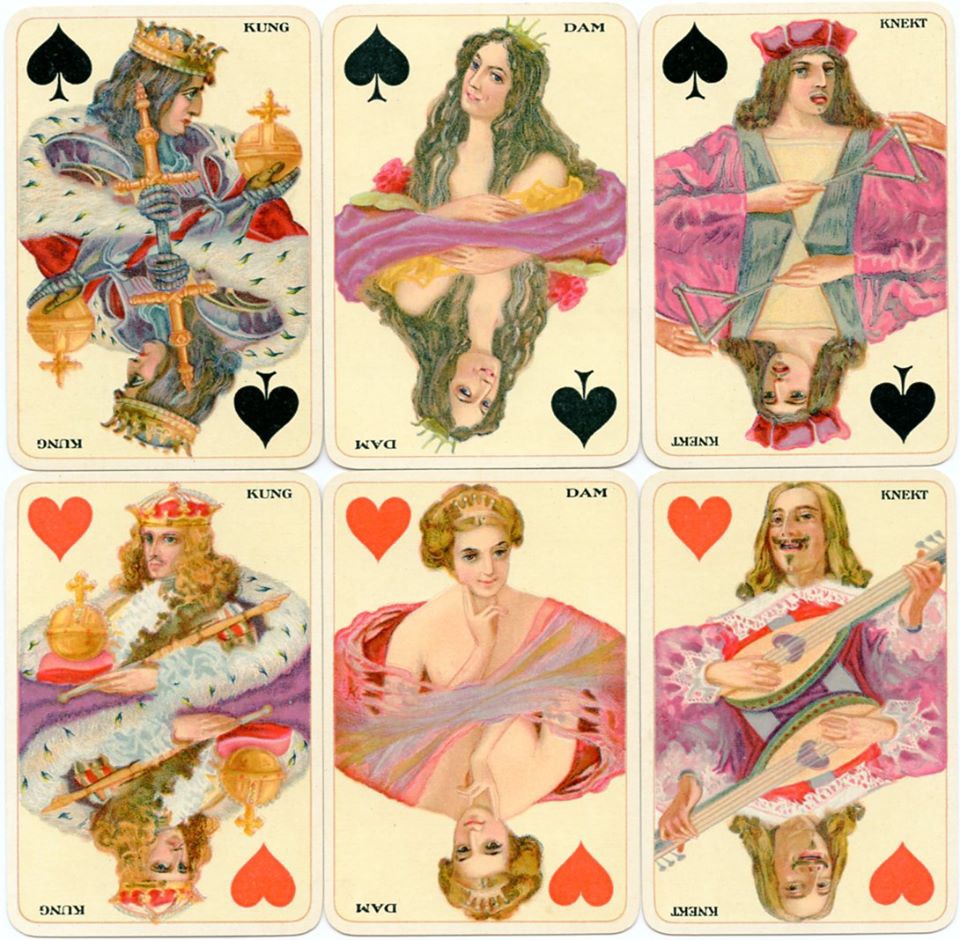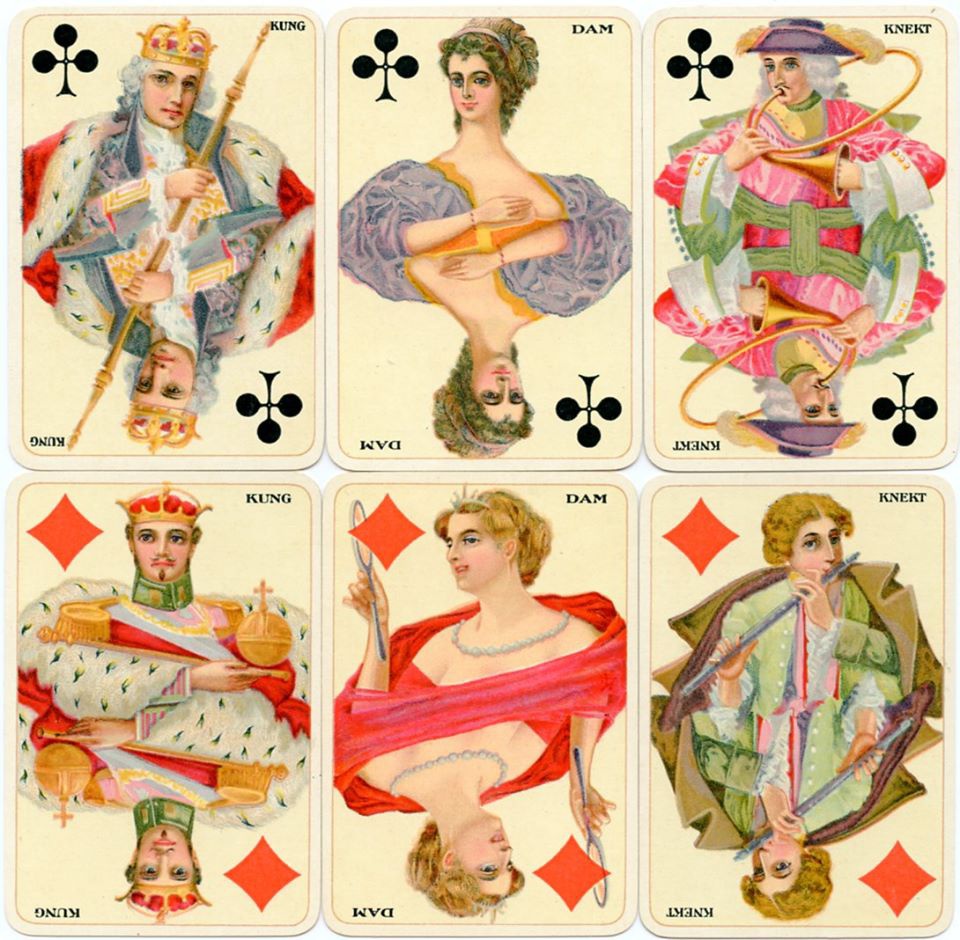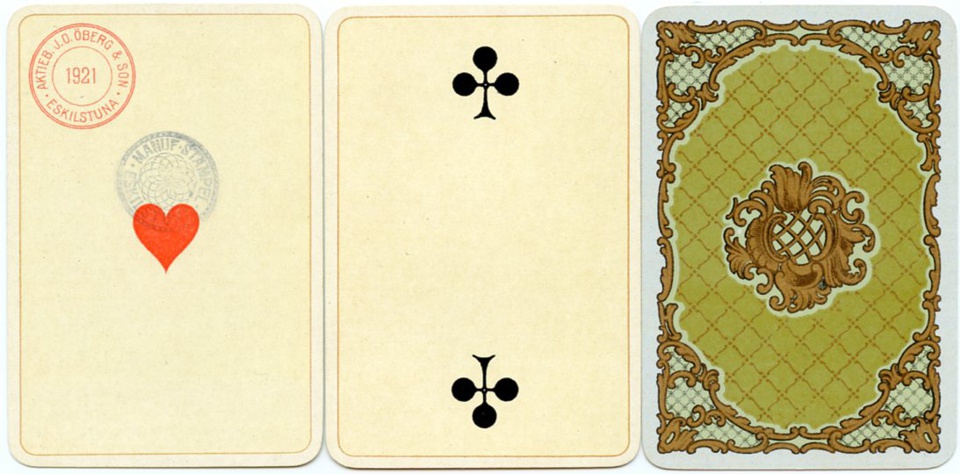
May 19
One more year and today's lockdown deck will be officially antique. This luxury deck was chromolithographically printed by J.O. Oberg & Son from Eskilstuna, Sweden. It was published since 1912 as Lyxkort Nr. 364 and has gold corners. The deck was in print until 1930. No joker was issued. The artist is unknown, but is said to have been famous in Sweden.
COMMENT
Ali Jerremalm:
If
you have time, you may read the article from Kartofilen 2/18 here:
BK was born in 1875 in Mariestad, son of an engine-driver.
Like the author Kar de Mumma, he was a student who spent two years in each
class, but was completely outstanding when it came to drawing. His gifts were
highlighted in the small town, and some more affluent citizens gathered a sum of
money so that he could get further education in Stockholm.
He was eventually accepted to the Academy of Fine Arts, where
he was a successful student in 1895-1900. Kronstrand was diligent but also
solved its tasks quickly and elegantly, apparently without much trouble. At the
academy he also learned the etching of Axel Tallberg, who a few years later
talked about his former student as a person "who could put life in the most
boring company. He is an acrobat, a magician, a sheriff, yes, God knows what he
is not.”
Bror Kronstrand's adventurous and successful life until 1937
(he died in 1950) has been extensively depicted by Sten Söderberg in a
magnificent work that I happened to get over in a small antique shop here in
Limmared. It was published in 1939 by C E Fritzes publishing house, as Fritzes
rarities III (Esselte printed, Nota bene, Norstedts (also an SLT company) did
the binding).
Bror Kronstrand came to be a supported portrait painter in
England, France, Russia, the United States and even South America, thus a world
traveler. And of course, hired and appreciated here at home. He was considered
almost as skilled as Zorn. If it was Zorn who got to paint the US president,
Kronstrand got to paint the President's wife (at this time her name was Taft).
Of course he often returned to his home country, where he got to paint both
royalty and other upper classes. Examples of people portrayed by BK are The
Swedish King Gustaf V, Queen Farida of Egypt, Queen Wilhelmina of Holland,
several Latin American presidents, the Swedish Prime Minister Per Albin Hansson,
Captain Tore Bendz at Öbergs (!) And many, many others. In Wikipedia it is
incorrectly stated that BK would have painted Alfred Nobel, but it was the
nephew, Emanuel Nobel, he painted. Of course, he served well on his portraits
and became an unusually wealthy artist. He was known to work very quickly; he
stated that, if needed, he could paint two portraits a day.
Kronstrand stated in a “Dagens Nyheter” interview about
his view of the art: - An artist should paint people the way they want to look
upon themselves. You pick up some of the most beautiful features and do
something about them. - The absolute equality I do not hold on - why should one
perpetuate something that is ugly?” His critics at home, however, often
considered that this was not a true artistic view and called him derogatory for
the ”Stockholm Society's quick painter".
In Paris, the portraits of Gustav V and PA Hansson were
exhibited in 1936, and Critical core Clément Morro wrote an appreciative
article about BK: "The characteristic of this artist is his way of
reproducing everything as accurately as possible, but at the same time his
models are seen through an artistic ambience and with a look that captures their
inner value and which intuitively transforms the matter and brings forth the
inner reality that only a great painter can evoke and which consists of the
invisible atmosphere around a face, the radiance of the soul behind it. It is
this property that Kronstrand occupies in such high measure and which is
excellent for a portrait painter with a mind for the psychic. "
In 1924 he married a woman he met 25 years earlier and became
more resident in Mariestad. In 1928 he got the title marshal of the court, in
1933 he became the 1st marshal of the court and then moved to the Capital. After
his wife's death in 1939, he married in 1942 with Sigrid Wigelius.
And where does Öberg's luxury cards come in? Well, not only
Bror was born and raised in Mariestad - it was also Tore Bendz, born 1874 as son
of the wholesaler Johan Adolf Bengtsson in Mariestad. Tore received an officer
training, but became in 1906, when he married Albert Öberg's only daughter
Inez, head of Öberg's office in Stockholm and in 1911 CEO of AB J O Öberg
& Son. Of course Bror and Tore knew each other since the growth. At the
portrait Bror made of Tore, if I read correctly, there is a dedication: "To
my friend Tore Bendz by B. Kronstrand". Tore's father probably belonged to
the group of more wealthy residents who collected money so that Bror could
improve his skills in Stockholm. Both of these gentlemen, Tore and Bror, were
happy old guys and came to hang out in about the same circles.
I think that Tore would like to give some kind of
"contribution" to the company, prove himself worthy not only as
son-in-law but also as director of the family business, and a luxury deck could
well be a suitable contribution? Öbergs could need one in order to be able to
compete fully with the finest decks from England and the continent. He simply
commissioned his talented friend to paint such a deck of cards. Well, since he
was at home in the etching art, could he possibly carry out the lithographic
work on such a deck? However, the work of a lithographer employed at Öbergs was
probably carried out. In terms of style, the court cards fit well into
Kronstrand's other production. He was a relatively young and creative artist,
open to various art forms.
Elisabeth Göthberg, member of the board of the Bror
Kronstrand society, has not heard of BK having made a deck of cards, but thinks
she can see BK's manners, especially in the "Queens". She promises to
have the issue of the deck with her in the future.
Linda Svensson, museum director at Vadsbo museum in
Mariestad, also did not know that BK would have made any deck of cards. There
are, however, in the collections a board game that he has drawn. –I believe he
also has designed playing cards, says Linda Svensson. But there is nothing I can
safely answer for. He has a large production and used to make jokes, made short
films and was a generally happy man who liked to do unexpected things. For a few
years he had painted his garden outdoors to get color on it before the leaves
and flowers struck out. We should keep our eyes open if we get any information
about this.
The ladies are signed with an underlined K, or KL. KL could
be interpreted like "Kronstrand lithographed" this deck. But if BK now
only painted the originals ("A prominent Swedish artist has thus performed
the original of the figures") and the lithographic work was performed by a
lithograph, L could stand for the lithograph's name. But it can simply be an
underlined K. That the artist did not appear openly with his name might perhaps
be because a deck of cards was not what an artist, who had his important
assignments within the upper class, at that time wanted to put on top of his
track record.


